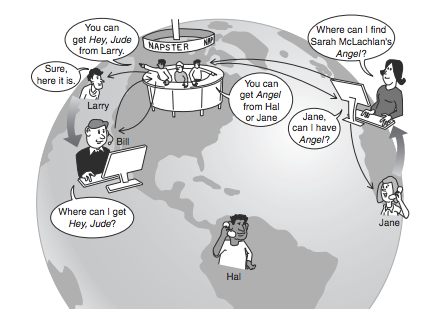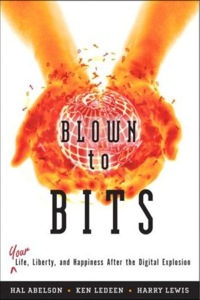
7.8. Impacts of CS Who Owns the Bits¶
Time Estimate: 135 minutes
7.8.1. Introduction and Goals¶
7.8.2. Learning Activities¶
Chapter 6: Copyright Rebalanced — An Evolution of Rights to Access the Bits
This lesson focuses on the question of use and ownership of digital media, including copyrighted media. It describes how file sharing algorithms should work and discusses some of the sensational cases in the battle between large media companies and users who use file sharing sites to share music and other media. Computing can play a role in social and political issues, which often raise legal and ethical concerns, especially if it is used to harm people.
Material created on a computer is the intellectual property of the creator or an organization. Ease of access and distribution of digitized information raises intellectual property concerns regarding ownership, value, and use. Measures should be taken to safeguard intellectual property, for example by citing work that is used but not your own. The use of material created by someone else without permission and presented as one’s own is plagiarism and may have legal consequences. Here are examples of legal ways to use materials created by someone else.- Creative Commons: a public copyright license that enables the free distribution of an otherwise copyrighted work. This is used when the content creator wants to give others the right to share, use, and build upon the work they have created.
- Open source software: programs that are made freely available and may be redistributed and modified
- Open access materials : online research output free of any and all restrictions on access and free of many restrictions on use, such as copyright or license restrictions
Before reading the chapter below, complete the Anticipation Guide and discuss with your classmates.
Here are some of the topics covered in the reading.- Copyright
- Peer-to-peer architecture/network
- Digital Millennium Copyright Act (DMCA)
- Open Access and Creative Commons
- Fair use
Activity 1: Read Chapter 6
Read Chapter 6 of the updated Blown to Bits. As you read the chapter, complete the Concept Bank worksheet. Review the illustration and video (up to 1:45) below to better understand how Napster works.
 |
Activity 2: Open Access Impacts on Science & Innovation
Watch the video below, an interview on paywalls and open access with NIH (National Institutes of Health) Director Francis Collins and inventor Jack Andraka. (Jack Andraka was mentioned in the chapter reading as having used the academic articles Aaron Swartz released in his reseach. Read more here.) After watching the video, discuss the following questions with your classmates.- Why was it important for Jack Andraka to have access to research articles? In what ways did he use the articles?
- How does the NIH policy align with Open Access and Creative Commons licenses?
- This is the executive order mentioned in the video. What are the benefits it cites to having open access to government data?
7.8.3. Summary¶
In this lesson, you learned how to:
7.8.4. Still Curious?¶
- This music video on copyright and fair use has a catchy tune and lots of good information!
- Open access can include Creative Commons licenses, but can also have fewer restrictions on them. Read more about Open Access on Wikipedia and about the different types of Creative Commons licenses.
- Want to learn more about Napster? AOL created a documentary called Downloaded about how it started, evolved with the court case, and eventually folded. You can watch the first 15 minutes on YouTube.
- Owners of copyrighted works can file complaints with various types of sharing services such as YouTube to have material removed. These complaints are available at LumenDatabase.org, formerly known as ChillingEffects.org. Try a search similar to the one mentioned in the book ("download [movie or song name]"). Then, look through the search results page for a notice about results being removed from DMCA complaints. Google's search results link to each of the complaints in Lumen.
7.8.5. Self Check¶
Here is a table of the technical terms introduced in this lesson. Hover over the terms to review the definitions.
| open access
Creative Commons fair use DMCA | peer-to-peer
copyright decentralized network centralized network DRM |
7.8.6. Reflection: For Your Portfolio¶
Answer the following portfolio reflection questions as directed by your instructor. Questions are also available in this Google Doc where you may use File/Make a Copy to make your own editable copy.
